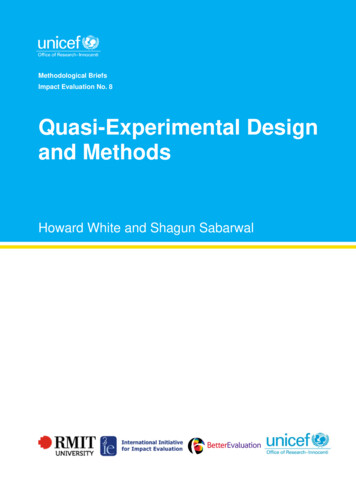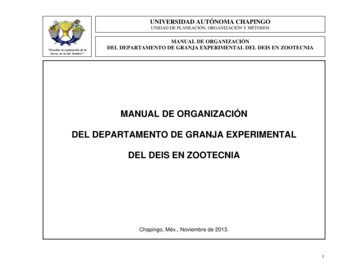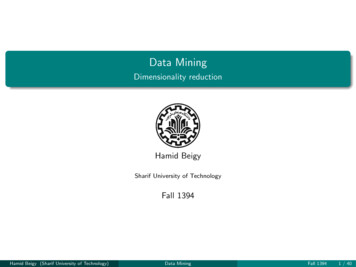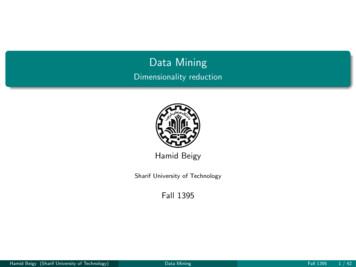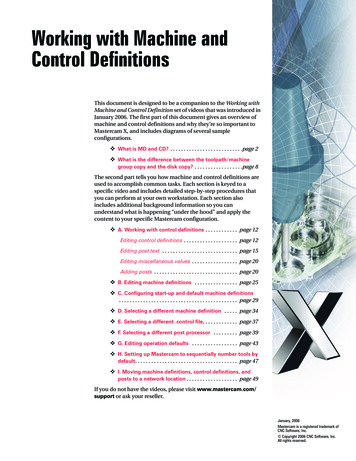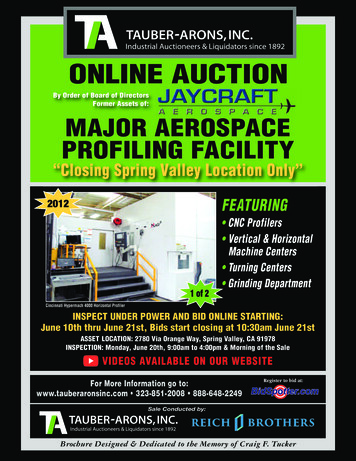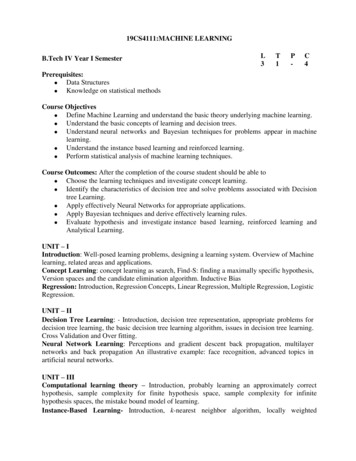
Transcription
Integrated Experimental Methods and MachineLearning for Tire Wear PredictionChuang SuDissertation submitted to the faculty of the Virginia Polytechnic Institute and StateUniversity in partial fulfillment of the requirements for the degree ofDoctor of PhilosophyInMechanical EngineeringTaheri, Saied. ChairAhmadian, MehdiSandu, CorinaTarazaga, Pablo A.Wang, LinbingFebruary 19, 2019Blacksburg, VAKeywords: tire wear, rubber abrasion, machine design, wear testing, machine learningCopyright 2019, Chuang Su
Integrated Experimental Methods and Machine Learning for Tire Wear PredictionChuang SuAbstractA major challenge in tire research, is tire wear modeling. There are too manyfactors affecting tire wear, and part of those factors are difficult to be accuratelyexpressed in physics and math.The objectives of this research is to develop a machine learning based rubbersample wear model, and find the correlation between sample wear and tire wear. Todevelop this model, accurate and diverse wear data is necessary. The Dynamic FrictionTester (DFT) was designed and built for this purpose. This test machine has made itpossible to collect accurate rubber sample wear data which has been validated underdifferent conditions. Wear tests under diverse test conditions were conducted, and the testdata were used to train machine learned based wear models with different algorithms,such as Neural Networks and Support Vector Machines. With test-proved wear behaviorclassification as additional input, and feature selection, performance of the trained rubbersample wear model has been further improved.To correlate rubber sample wear and tire wear, a set of correlation functions weredeveloped and proposed. By validating the correlation functions using tire wear datacollected from the modified Rolling Resistance machine and road tests, this researchcontributes a fast and economical approach to predict tire wear.
Integrated Experimental Methods and Machine Learning for Tire Wear PredictionChuang SuGeneral Audience AbstractTire wear is closely related to the life time of tire, and excessive wear of tire canresults in serious accidents. Since 1950s, research have been done to predict tire wearusing experiments and empirical relations. These approaches are expensive, timeconsuming, and highly restricted to certain conditions.The objectives of this research is to develop a statistic based rubber sample wearmodel, and find the correlation between rubber sample wear and tire wear. To developthe statistic based rubber sample wear model, a test machine, named Dynamic FrictionTester (DFT) was designed and built to collect rubber sample wear data. The final rubbersample wear model is trained by wear data under 600 different test conditions. A set ofmathematical equations were proposed to correlate rubber sample wear and tire wear.These equations were validated by actual tire wear data collected from lab and publicroads.In combination of the statistic based rubber sample wear model and mathematicalrelation between rubber sample wear and tire wear, this research contributes a flexible,economical, and fast method to predict tire wear.
AcknowledgementsForemost, I owe my deepest gratitude to my advisor, Dr. Saied Taheri for hisencouragement, patience, support and guidance throughout my PhD study. I would like tothank my committee members: Dr. Mehdi Ahmadian, Dr. Corina Sandu, Dr. PabloTarazaga, and Dr. Linbing Wang, for their encouragement and comments.I thank Michael Craft, Mehran Motamedi, Karan Khanse, Hongxiao Yu, and EricPierce for their assistance in building the DFT. I must acknowledge Anahita Emami andSunish Vadakkeveetil for their cooperation in Multiscale Modeling of Tire Wear project.I thank Dr. Mehdi Ashraf-Khorasani for his assistance in toluene tests for rubberparticles. As a team project, I thank Surabhi, Waleed, Arash, Chidambaram, Ashkan, andother students for their contribution and devotion in modifying the rolling resistancemachine. I would like to thank Karthik, Mehran Shams Kondori, and Anish for theirassistance in tire wear tests on the RR machine.I thank Center for Tire Research (CenTiRe) Industry Advisory Board Membersfor their technical and financial support. Special thanks goes to Dr. Toshio Tada andShinya Nakano from Sumitomo Rubber, who provided us with lots of useful suggestionsand most importantly, rubber samples and tires.I thank my parents for their irreplaceable support throughout my life.Lastly, I would like to thank friends that I met during these years at VirginiaTech.iv
Table of ContentsAbstract . iiGeneral Audience Abstract . iiiAcknowledgements . ivList of Figures . viiiList of Tables . xii1. Introduction . 11.1Motivation . 11.2Main Contributions . 21.3Document Outline . 32. Literature Review. 42.1Physics behind Rubber/Tire Wear. 42.1.1Crack Initiation and Propagation . 52.1.2Major Factors Affecting Rubber Abrasion . 122.1.3Major Factors Affecting Tire Wear . 162.1.4Empirical Wear Models . 192.2Materials of Rubber/Tire and oxidation . 222.2.1Materials . 222.2.2Rubber Oxidation . 242.3Rubber/Tire Friction/Wear Test Machines and Methods . 302.3.1Principles of Experimental Design . 302.3.2Indoor Rubber Tests . 312.3.3Indoor Tire Tests . 352.3.4Outdoor Tire Tests . 382.3.5Summary of Wear Test Machines and Methods . 423. Design/build Test Rigs . 443.1Design and build the Dynamic Friction Tester (DFT) . 443.1.1Structure of the DFT . 443.1.2Choice of Sample Shape and Motion Type . 473.1.3Sliding Velocity Control . 49v
3.1.4Loading Mechanism. 503.1.5Wear Measurement . 513.1.6Sensors on the DFT . 533.1.7Procedures of Rubber Sample Wear Test . 543.2Design of the Trailer-Axle Tire Friction Tester . 553.2.1Structure . 563.2.2Key Components . 583.2.3Sensors on the Trailer-Axle Tire Friction Tester . 593.2.4Issues of the Design . 603.3Modification of the Rolling Resistance Machine for Wear Testing . 613.3.1Structure . 623.3.2Sensors . 653.3.3Comparison with Trailer-Axle Tire Friction Tester. 664. Supervised Machine Learning . 684.1Additive Models and Trees . 684.1.1Generalized Additive Models . 694.1.2Tree-based Methods . 694.2Boosting Methods . 714.2.1AdaBoost. 714.2.2Boosting Trees . 724.3Tree Bagging and Random Forest . 744.4Neural Networks . 744.4.1Components of a Neural Network . 754.4.2Fit a Neural Network . 764.4.3Network Topology . 774.5Support Vector Machines . 784.5.1Basic of SVM . 794.5.2Constructing the Optimal Hyperplane . 804.5.3Kernel Trick . 814.5.4Least Squares Support Vector Machine . 834.5.5Applications of SVM in Wear Prediction . 844.6Comparison of Machine Learning Methods. 86vi
4.6.1Coefficient of Determination . 864.6.2Prediction Error . 874.6.3Cross-validation . 884.6.4General Comparison of Supervised Machine Learning Models . 894.7Dimension Reduction . 904.8Choices of Inputs and Response for Rubber Sample Wear Model . 924.9Validation of the Wear Modeling Method . 944.10Choosing Machine Learning Algorithms for Wear Modeling . 985. Results . 1005.1DFT Performance Evaluation. 1005.1.1Evaluation of Sensor Data . 1015.1.2Evaluation of Sliding Velocity Control . 1035.1.3Fluctuation of Normal Load. 1035.1.4Repeatability of Wear Test . 1045.2Initial Machine Learning Based Rubber Wear Modeling . 1055.2.1Contact Patch Area of Rubber Samples . 1065.2.2Effective Radius of Rubber Sample . 1085.2.3Performance of Different Machine Learning Based Wear Models . 1095.3Improvement of Rubber Wear Model . 1115.3.1Introducing the Influence of Oxidation. 1115.3.2Feature Selection . 1175.4Complete Rubber Wear Model . 1185.5Correlation of Rubber Wear and Tire Wear . 1245.5.1Converting Parameters of Tire Wear into Rubber Wear . 1245.5.2Tire Wear Tests . 1305.5.3Validation of the Conversion Functions . 1336. Conclusions . 1397. Future Work . 142References . 143vii
List of FiguresFigure 1. Apparatus for testing friction and wear of rubber (Fukahori & Yamazaki, 1994). 6Figure 2. Friction vs. sliding time and acceleration vs. sliding time (Fukahori &Yamazaki, 1994) . 7Figure 3. Initial cracks after 100 revolutions with 20 N normal load (Fukahori, Liang, &Busfield, 2008) . 7Figure 4. Abrasion pattern at the steady state at 20 N (Fukahori, Liang, & Busfield, 2008). 8Figure 5. Model of a single ridge subject to friction (Fukahori & Yamazaki, 1995) . 9Figure 6. Model of hard slider on rubber surface (Fukahori & Yamazaki, 1995) . 10Figure 7. Cut growth rate vs. tearing energy (Lake & Lindley, 1965) . 13Figure 8. Sliding abrasion vs. temperature at 0.01m/s sliding velocity. (A) SBR, (B)ABR, (C) NR. --- tread compound, - gum compound (Gent & Walter, 2006) . 14Figure 9. Log abrasion rate vs. load at different slip angles at a speed of 19.2km/h (Gent& Walter, 2006) . 15Figure 10. (a) Abrasion rate vs. slip angle at 76 N load and 19.2km/h speed (b)logarithmic scales (Gent & Walter, 2006) . 15Figure 11. Log abrasion vs. log energy dissipation for two compounds and two surfaces(Gent & Walter, 2006) . 16Figure 12. Log tire wear rate vs. long slip angle (Grosch & Schallamach, 1961) . 17Figure 13. Abrasion of NR and SBR compounds vs. tire surface temperature (Grosch &Schallamach, 1961) . 17Figure 14. Wear rate of bias ply tire compared with radial ply tire (Gent & Walter, 2006). 18Figure 15. In a controlled road wear test (a) Distribution of cornering acceleration (b)Distribution of fore and aft accelerations (Gent & Walter, 2006) . 19Figure 16. Distribution of speed in a controlled road wear test (Gent & Walter, 2006) . 19Figure 17. Testing scheme for evaluating coefficients of abrasion equation . 21viii
Figure 18. chemical structure of vulcanized natural rubber (Jü, 2011) . 24Figure 19. Relative temperature dependence of permeability and oxidation rate of NR(Baldwin & Bauer, 2008) . 26Figure 20. Ahagon plot of retrieved on-road and spare tires . 27Figure 21. Ahagon plot of oven aged tires (Baldwin & Bauer, 2008) . 28Figure 22. Peel strength vs. shifted time. Shift factors (SF) are in the legend (Baldwin,Bauer, & Ellwood, 2005) . 29Figure 23. Dependence of rubber oxidation on oven temperature (Baldwin & Bauer,2008) . 29Figure 24. (a) Sketch of the Dynamic Frictional Property Test Machine; (b) Principle offriction measurement (Frictional property tester of JLU, 2012) . 32Figure 25. (a) Contact geometries; (b) TE 75 rubber friction test machine (George, 2017). 33Figure 26. High Speed Linear Friction Tester (Berres & Barz, 2017) . 34Figure 27. LAT100 Compound Tester (Description – Laboratory Abrasion & Skid Tester,2014) . 35Figure 28. Rotating disk machine (Berritta, Cossalter, Doria, & Ruffo, 2002) . 36Figure 29. MTS Tire Rolling Resistance System (Tire Rolling Resistance MeasurementSystem, 2014) . 36Figure 30. Flat-Trac Tire Test System (Flat-Trac Tire Test Systems, 2014) . 37Figure 31. Tire Tread Wear Simulation System (Tire Tread Wear Simulation System,2014) . 38Figure 32. RoaDyn S630 sp System 2000 (Kistler, 2010) . 39Figure 33. ASFT Mk IV Rear -axle (Fernando, 2009) . 40Figure 34. Test course (Beebe, 2004) . 41Figure 35. The “Forward X” rotation plan (Beebe, 2004) . 41Figure 36. Front view (a) and left view (b) of the DFT . 46Figure 37. Rubber samples . 48Figure 38. Base of road surface . 49Figure 39. Kollmorgen AKM 4x servomotor . 49Figure 40. Loading mechanism. 51ix
Figure 41. Rubber sample hub (transparent part is rubber sample) . 52Figure 42. HRB-303 high resolution balance (Lim, 2016) . 52Figure 43. Load cells measuring normal load and longitudinal friction force (highlightedin green squares) . 53Figure 44. Dynamic Friction Tester . 55Figure 45. Trailer in our lab . 56Figure 46. Trailer-Axle Tire Friction Tester . 57Figure 47. Normal load control . 59Figure 48. VBOX speed sensor . 60Figure 49. LW12.8 Wheel Load Transducer and its application (LW12.8, 2017) . 60Figure 50. Vibration isolation of the machine . 62Figure 51. Tire positioning mechanism (Ramdasi, 2016). 63Figure 52. Modified rolling resistance machine (drive motor not included) . 65Figure 53. Partitions and CART (Hastie, Tibshirani, & Friedman, 2001). 70Figure 54. Data processing in a neuron . 75Figure 55. Feed forward neuron network (Feedforward neural network, 2017) . 78Figure 56. Optimal separating hyperplane with maximum margin (Hofmann, 2006) . 79Figure 57. Mapping from 2-D space to 3-D space (Weston, 2006) . 82Figure 58. Definition of flank wear of broaching tool: (a) fresh tool, (b) worn tool (Shi &Gindy, 2007) . 84Figure 59. Comparison between predicted wear and wear measured by microscope (Shi& Gindy, 2007) . 85Figure 60. Experimental milling process (Slavkovic, Jugovic, Dragicevic, Jovicic, &Slavkovic, 2013) . 85Figure 61. SVR implementation (Slavkovic, Jugovic, Dragicevic, Jovicic, & Slavkovic,2013) . 86Figure 62. RMS values of different kernel functions (Slavkovic, Jugovic, Dragicevic,Jovicic, & Slavkovic, 2013) . 86Figure 63. Dataset division . 87Figure 64. Training process of rubber sample wear model . 94Figure 65. Process of training friction model trained by early wear data . 95x
Figure 66. Response plot of linear regression based friction modeling. Blue dots: trueresponse, orange dots: predicted response . 96Figure 67. Structure of the 2-layer feedforward neural network . 97Figure 68. Error histogram of ANN based friction model trained by early data . 97Figure 69. Plot of calculated loads and measurements . 102Figure 70. Motor shaft position curve. (a): case 1; (b): case 2 . 103Figure 71. Normal load data during wear tests . 104Figure 72. Red patches on prescale film representing the sample contact patch . 106Figure 73. Contact patch area vs. load (rubber compound A) . 107Figure 74. Contact patch pressure vs. load (compound A) . 108Figure 75. Rc vs. FN (compound A) . 109Figure 76. Wear rates of compound C on P120 sandpaper. 113Figure 77. Contact patch temperature of compound C on P120 sandpaper. 114Figure 78. Relationship of road smoothness, severity of dynamics, and abrasion behavior.(a) NR. (b) Synthetic rubber . 116Figure 79. Structure of final rubber wear model. 120Figure 80. wear rate vs. normal load – sliding velocity. Compound E on P120 sandpaper. 121Figure 81. Test and predictions of wear rate vs. normal load . 122Figure 82. Test and predictions of wear rate vs. sliding velocity . 123Figure 83. Test and predictions of wear rate vs. tensile strength . 124Figure 84. Standard tread measurement. 131xi
List of TablesTable 1. Comparison of sample shapes and types of motion . 47Table 2. Comparisons of different loading mechanism . 50Table 3. Comparison of original and modified rolling resistance machine . 62Table 4. Comparison of supervised machine learning models . 89Table 5. Data categorization of wear tests on DFT . 92Table 6. Inputs of rubber sample wear model (early stage) . 93Table 7. Conditions of early wear test data. 95Table 8. Calculated load and sensor measurements. 101Table 9. Temperature measurements . 102Table 10. Standard deviation of repeated wear tests. 104Table 11. Contact patch test results (compound A) . 106Table 12. Rubber sample deformation test results (compound A) . 108Table 13. Test configurations for model comparison . 110Table 14. Performance comparison of machine learning algorithms . 111Table 15. Correlation of test conditions and oxidation . 114Table 16. Classification of rubber abrasion behaviors. 115Table 17. Toluene test conditions . 116Table 18. Comparison of reference and select-feature wear models . 118Table 19. Final wear test configurations . 119Table 20. Comparison of last-four wear models . 120Table 21. Rubber wear model and tire wear influential factors . 125Table 22. Parameters of wear tests on RR machine. 130Table 23. Tread depth measurements of RR machine tests (in mm) . 131Table 24. Parameters of tire wear tests on road . 132Table 25. Route map information . 132Table 26. Tread depth of tire A2 . 133Table 27. Constants and coefficients of tire wear test on RR machine . 134Table 28. Constants and coefficients of tire wear test on road . 136xii
Table 29. Predicted weight loss in each road segment . 137xiii
1. Introduction1.1MotivationAn important problem in tire research, is tire wear prediction. Although thisproblem exists from the day when pneumatic tires were invented, there are not anywidely-recognized models for tire wear. This is because there are too many physical andchemical factors affecting tire wear, and part of those factors are difficult to be accuratelyexpressed in mathematical forms.Nowadays, machine learning is
the statistic based rubber sample wear model, a test machine, named Dynamic Friction Tester (DFT) was designed and built to collect rubber sample wear data. The final rubber sample wear model is trained by wear data under 600 different test conditions. A set of mathematical equations were proposed to correlate rubber sample wear and tire wear.

